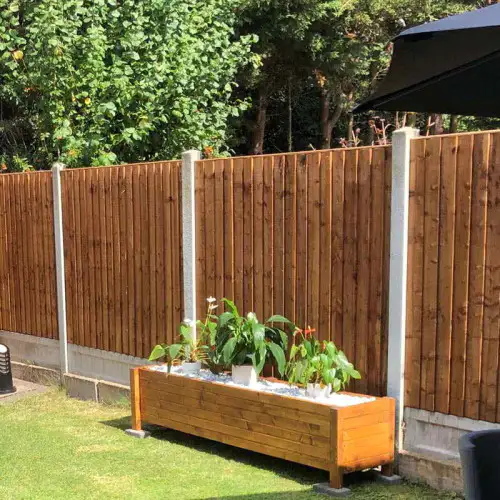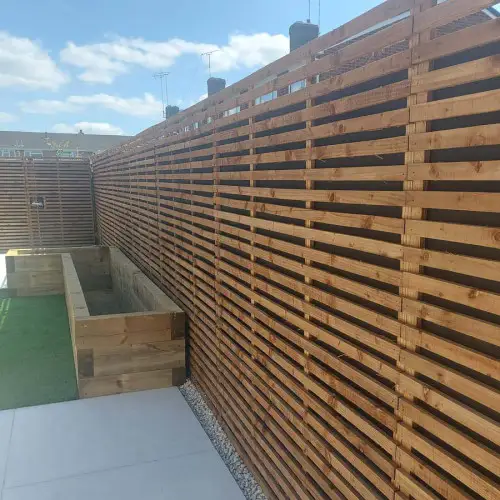Your shopping cart is empty!
At East Coast Fencing, we are your go-to supplier for high-quality fence panel..
Trellis panels are the perfect addition to any garden, bringing both functiona..
Our extensive range of fence posts includes both concrete and wooden fence pos..
Timber is a essential for construction, landscaping, and various DIY projects...
Whether you're a DIY enthusiast, a homeowner looking to upgrade your exterior,..
Railway sleepers are a versatile and popular choice for various landscaping an..
When it comes to enhancing the aesthetic appeal and security of your property,..
Ironmongery, often overlooked, plays a crucial role in the functionality and a..
Introducing our Cement Products range at East Coast Fencing, the reliable choi..
Closeboard fence panels are a popular choice among homeowners. They offer strength, durability, and ..
Decorative fence panels offer a blend of form and function, providing homeowners and DIY enthusiasts..
Elevate your garden's aesthetics and functionality with our range of fence topper trellises. Designe..
Explore our selection of concrete fence posts, the foundation for a strong, durable, and maintenance..
Discover our range of durable wooden fence posts, designed to meet all your gardening and landscapin..
If you're looking to enhance the aesthetic appeal of your garden, our picket fence panels offer the ..
Trending Products
Discover the unmatched durability and craftsmanship of East Coast Fencing's 6FT x 5FT ultra heavy duty closeboard fence panels. These panels are engin..
from
£39.99 £46.99
EX VAT:£33.33Our 6FT x 6FT waney lap fence panels are the epitome of robust and reliable garden fencing. Crafted with precision, each panel is pressure treated in ..
from
£29.99 £34.99
EX VAT:£24.99Discover the strength and durability of our 8FT Concrete Intermediate Fence Post, a crucial component for any fencing project. Expertly designed, this..
from
£28.99
EX VAT:£24.16Introducing our robust 2.4M x 100 x 100mm Wooden Fence Post, the backbone for any sturdy and long-lasting garden fencing project. Crafted with precisi..
from
£18.99
EX VAT:£15.83The 6FT x 6FT Contemporary Double Slatted Fence Panel bring style and durability together, offering a modern solution for your outdoor space. These sl..
from
£90.99 £106.49
EX VAT:£75.83Elevate your garden's elegance and ensure its longevity with our premium 6 Inch Smooth Concrete Gravel Board. Expertly designed for the discerning hom..
from
£18.49
EX VAT:£15.41Discover unparalleled durability and support for your fencing with our 12 Inch Recessed Concrete Gravel Board. Expertly designed, this gravel board is..
from
£24.49
EX VAT:£20.41Our 6FT x 5FT waney lap fence panels are the epitome of robust and reliable garden fencing. Crafted with precision, each panel is pressure treated in ..
from
£25.99 £29.99
EX VAT:£21.66Introducing the 6FT x 6FT Closeboard Fence Panel from East Coast Fencing, a product crafted with precision and care to offer you both durability and a..
from
£44.99 £52.49
EX VAT:£37.49Introducing the 6FT x 6FT Ultra Heavy Duty Closeboard Fence Panel, a premium choice for those seeking strength and durability in their fencing solutio..
from
£47.49 £55.49
EX VAT:£39.58Looking for a dependable solution to secure the borders of your garden? Consider the 6FT x 6FT closeboard fence panel, a perfect blend of durability a..
from
£44.99 £52.49
EX VAT:£37.49Discover the perfect addition to your garden with our 1.83M x 1.83M Slatted Trellis. Crafted for durability and aesthetic appeal, this trellis panel i..
from
£39.99
EX VAT:£33.33Our 6FT x 3FT waney lap fence panels are the epitome of robust and reliable garden fencing. Crafted with precision, each panel is pressure treated in ..
from
£18.49 £21.49
EX VAT:£15.41Elevate your garden's aesthetics with our premium 1.83M x 0.6M Slatted Trellis, a perfect blend of functionality and style. This tastefully designed s..
from
£18.49
EX VAT:£15.41Introducing the 6FT x 4FT Closeboard Fence Panel, a premium offering from East Coast Fencing, renowned for its high-quality construction and durabilit..
from
£32.99 £38.49
EX VAT:£27.49Introducing the 9FT Concrete Intermediate Fence Post, a robust and durable solution for your fencing needs. Expertly crafted through a wet cast proces..
from
£32.99
EX VAT:£27.49Our 6FT x 4FT waney lap fence panels are the epitome of robust and reliable garden fencing. Crafted with precision, each panel is pressure treated in ..
from
£21.99 £25.49
EX VAT:£18.33Discover the exceptional durability and craftsmanship of East Coast Fencing's 6FT x 5FT 6 Inch ultra heavy duty closeboard fence panels. Precision-eng..
from
£42.49 £49.49
EX VAT:£35.41Introducing the 6FT x 4FT ultra heavy duty closeboard fence panel, your ultimate solution for enduring strength and style from East Coast Fencing. The..
from
£35.49 £41.49
EX VAT:£29.58Discover the strength and durability your garden fencing needs with our 2.4M x 100 x 100mm Wooden Fence Post. Expertly crafted to stand the test of ti..
from
£18.99
EX VAT:£15.83Elevate the durability and aesthetic of your garden fencing with our 12 Inch Smooth Concrete Gravel Board. Expertly designed for longevity and strengt..
from
£26.99
EX VAT:£22.49Introducing the 6FT x 3FT closeboard fence panel from East Coast Fencing, a product that combines durability and style. Crafted with precision, these ..
from
£27.99 £32.49
EX VAT:£23.33Our 6FT x 5FT waney lap fence panels are the epitome of robust and reliable garden fencing. Crafted with precision, each panel is pressure treated in ..
from
£25.99 £29.99
EX VAT:£21.66Our 6FT x 6FT waney lap fence panels are the epitome of robust and reliable garden fencing. Crafted with precision, each panel is pressure treated in ..
from
£29.99 £34.99
EX VAT:£24.99








































